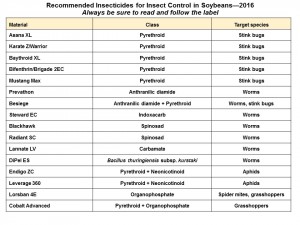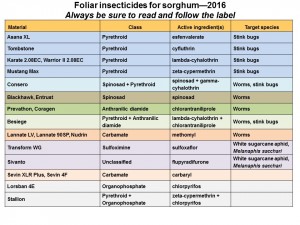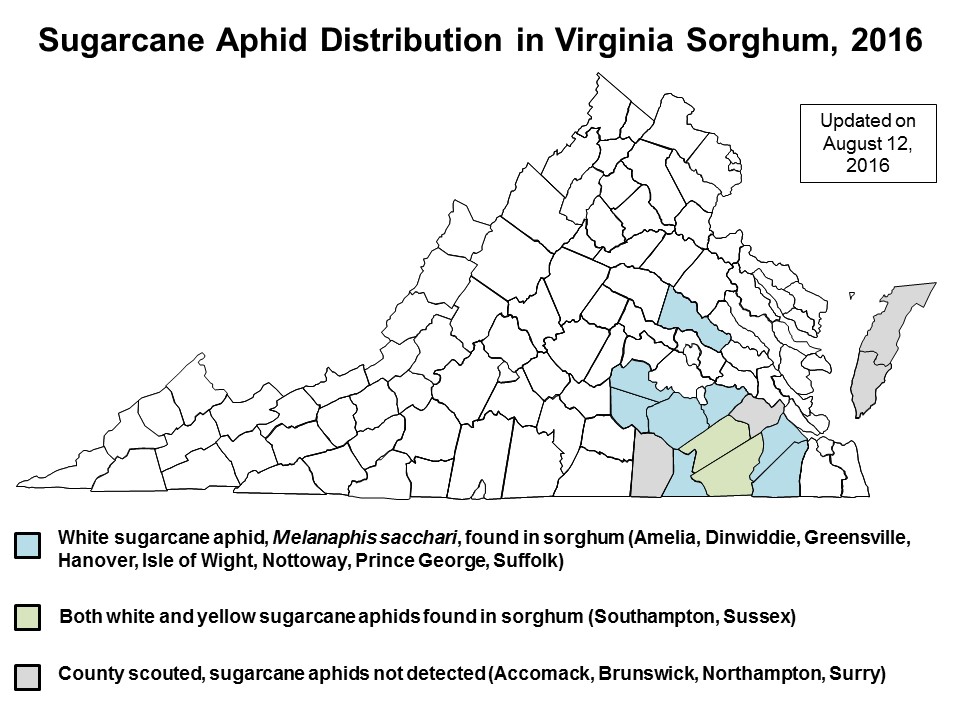In general, corn earworm moth counts were similar to last week; brown marmorated stink bug counts were low (moderate in Warwaw). Please see the attachment for more details: BLT_18_Aug_2016
Corn earworm soybean update.
In both 2014 and 2015 we experienced very light corn earworm (CEW) infestations in our soybean crop. This summer we are back to a more normal situation with spotty light to moderate level infestations. Some fields have hit thresholds for sure, but not all. And, as is the case in most years, worms are in some fields that are only in the flowering stage—which has been proven many times over the years NOT to be a problem, that is, does NOT result in any yield loss. CEW do their damage when they feed on developing seed during the R5-R6 growth stages. If needed, a single application (if the right insecticide is used) during this stage should be all that is needed for season-long CEW control.
As always, in a year with spotty infestations, it pays to scout fields carefully to find those at threshold so they can be protected. We have recently proven that pyrethoid insecticides have a devastating effect on the thousands of beneficial insects and spiders in a soybean field. If left alone, they have then potential to control CEW infestations by eating the eggs and small worms and therefore prevent the need for an insecticide spray. So, be careful with pyrethroid applications and use them only if thresholds are met. You will very likely save money in the long run.
What are the thresholds for CEW in soybean? There is not a one-size-fits-all answer. This fact sheet Soybean_insect_mgmt_2016 has a CEW Calculator that can provide a good answer based on some of the factors that must be considered—like the estimated application cost and bushel value. Use this as a starting point.
What to treat with? We have been monitoring CEW for pyrethroid insecticide resistance for several years by collecting and testing adults (moths). This year is no exception. Individual moths are exposed to a pyrethroid and we document the percent that survive (=resistant). This year we are seeing high levels of survivorship averaging about 40% over all sample dates and locations. This means that to achieve good CEW control, non-pyrethoids insecticides should be considered. For CEW, I would focus on those that ‘specialize’ in worm control (like Prevathon, Besiege, or Spinosad). Lannate is another option but has essentially zero residual activity, whereas the others should provide several days of protection, depending on rainfall amounts and frequency. If stink bugs are also present in the field, the worm products will not be effective. A pyrethroid will need to be tank mixed with the worm product (example, Prevathon plus bifenthren)—or a product like Besiege can be used that contains both a worm product and a pyrethroid. Below is a list of insecticides labeled for use in soybean.
Sorghum insect pest update: headworms and aphids
Headworms: Corn earworm (CEW) is the primary headworm pest of Virginia sorghum and this summer CEW populations are higher than in the past two years. Sorghum heads are very attractive to worms—but not until the seed begins to form. I suggest that sorghum is so attractive to this pest that every field will be infested at some point. If you are not scouting your sorghum fields for CEW and not treating, it is very likely that heads are being damaged. And, not only do worms do direct damage to the developing seed, damaged seed are more likely to be infested by the fungi that produce mycotoxins which can further degrade seed quality.
So bottom line, scout fields and sample heads for worms by shaking heads into a white or light colored 5-gal bucket. In our experience, this is the ONLY way to get an accurate count. The standard headworm threshold across the U.S. is an average of 1 to 2 worms per head during seed formation.
What to treat with? We have been monitoring CEW for pyrethroid insecticide resistance for several years by collecting and testing adults (moths). This year is no exception. Individual moths are exposed to a pyrethroid and we document the percent that survive (=resistant). This year we are seeing high levels of survivorship averaging about 40% over all sample dates and locations. This means that to achieve good CEW control, non-pyrethoids insecticides should be considered. Posted below is a link to a list of insecticides labeled for use in sorghum. For CEW, I would focus on those that ‘specialize’ in worm control (like Prevathon, Besiege, or Spinosad). Lannate is another option but has essentially zero residual activity, whereas the others should provide several days of protection, depending on rainfall amounts and frequency.
Aphids: We have posted several advisories about the sugarcane aphid (SCA) infestation in our sorghum. Bottom line, fields need to be scouted following the procedures and thresholds provided in the linked fact sheet. Only Sivanto or Transform insecticides are known to be really effective against this aphid species.
Fields with CEW and SCA: If thresholds of both pests are found, insecticide tank mixes are the only option—to include a CEW product as mentioned above, and either Sivanto or Transform for SCA. Of course this adds a lot to the cost of producing sorghum. More details on both headworms and aphids can be found at this link. Midseason sorghum insect pests
White sugarcane aphid update for August 18, 2016
BMSB and kudzu bug survey of soybean update for Aug. 18, 2016
Our scouts Ed and Jamie found brown marmorated stink bug (BMSB) in 5 more Virginia counties this week (Pittsylvania, Spotsylvania, Louisa, Campbell, and Prince Edward). All fields reported were below threshold for BMSB.
Kudzu bugs were found in 4 more counties (Pittsylvania, Mecklenburg, Spotsylvania, and Orange). All fields were below threshold.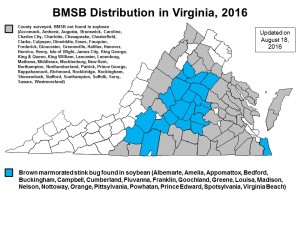

Cotton insect pest update—bollworms are here.
At this point in the season, many cotton fields have been treated once for mid-season plant bug/stink bug. The next decision will be focused on bollworm control—whether it is needed, and if so, what insecticides to use. We are seeing a general increase in bollworm moth activity at TAREC and have gotten recent reports of some pretty large worm infestations in a couple of peanut fields in the cotton area, and outbreaks in a couple of soybean fields in the Suffolk area. Caution: if the earlier applied mid-season plant bug/stink bug spray included a pyrethroid (e.g., bifenthrin), the beneficial populations in those fields will have been depleted—which makes them more susceptible to bollworm.
We have plenty of data that shows that cotton varieties with bollworm protection traits can be damaged by worms. Some escape the toxin, survive, and feed on bolls. We have seen as much as 9% or more boll damage in some varieties which is 3 times our working threshold of 3% live worms/fresh boll damage. But, that was in years when bollworm pressure was high. In years like 2014 and 2015 when bollworm populations were very light, we saw essentially no boll damage in any of the varieties. So what is the 2016 situation? So far it looks like we may be looking at heavier pressure than last year, light to moderate depending on the field—but—we won’t know for sure for another few weeks—as the main flight out of field corn has not kicked in yet. The corn crop is generally a little behind and a little less mature than normal for this time of year because of later planting and good rainfall.
The best approach for managing bollworm in cotton is to scout fields for worms by inspecting small bolls, the terminals, and under flowers (boll tags) for live worms or damage. As mentioned, our current threshold is 3% of the fruit or positions inspected with either live worms or damage.
We have a history of bollworm resistance to pyrethroids in Virginia and this year is no exception. Of the 650 or so moths tested so far, we are seeing about 40+% survival. This is high. So for the best control results we suggest using a non-pyrethroid (e.g., Prevathon, Belt, Blackhawk, or Intrepid Edge). Note that Belt is not widely available this season due to the registration being canceled by EPA. Distributors and growers can use existing stocks according to label, but when that is gone, that will be it—at least as far as we know.
We also recommend adding a pyrethroid to the worm product to clean up any plant bugs/stink bugs that may be in the cotton. There are several pyrethroid options, and I would use the highest labelled rate for stink bugs—for better kill and longer residual. Besiege is the only product that contains both the non-pyrethroid (= Prevathon) with a pyrethroid (= Karate). With all the other non-pyrethroids, you will have to do the tank mixing on the farm. And, it is past time to include any of the insecticides in the neonicotinoid class as they do not provide good control of either bollworms or stink bugs.
Corn earworm (bollworm) and BMSB update for Aug. 11, 2016
NIghtly black light trap captures of corn earworm (bollworm) moths rose sharply at most reporting stations this week. Historically, this time of year is when we see our peak moth flight occur, which is followed by egg laying. Mike Arrington (Tidewater AREC Entomology) found an average of 12 bollworm eggs per 100 bloom/bloom tags in Suffolk cotton, which is almost egg threshold (the Pest Management Guide defines the egg threshold as 15-20 eggs per 100 blooms or bloom tags for Bollgard cotton). In peanut, a field near Stony Creek (Sussex Co.) had threshold numbers of corn earworm larvae (4 larvae per row foot when using a beat cloth).
Black light traps caught low to moderate numbers of brown marmorated stink bugs (BMSB) this week, ranging from zero in some locations, to over 5 per night at Warsaw. BMSB findings from the statewide soybean survey are mentioned in my August 9th post. Please see the attached pdf for the black light trap tables for both of these pest species: blt_11_Aug_2016
Sorghum: sugarcane aphid update for Aug. 11, 2016
BMSB and kudzu bug update for Aug. 9, 2016
Our soybean scouts found brown marmorated stink bug (BMSB) in soybean in nine more Virginia counties last week (Goochland, Fluvanna, Albemarle, Buckingham, Greene, Cumberland, Nelson, Bedford, and Franklin). The Bedford soybean field was in the R4 growth stage, and was above threshold with 8 BMSB observed in a 2-minute visual count (the threshold is 3-5). More scouting, management, and other information can be found in the publication, “Brown Marmorated Stink Bug Biology and Management in Mid-Atlantic Soybeans.” Nelson county was just reaching threshold with 3 BMSB in a 2-minute visual count; all other “positive” counties had relatively low numbers of BMSB reported. Here is the map for the season:
Kudzu bugs were detected in nine new Virginia counties last week (Fluvanna, Albemarle, Cumberland, Powhatan, Nottoway, Louisa, Greene, Amherst, and Henry). None of them were near the threshold of 1 kudzu bug nymph per sweep. The kudzu bug map:
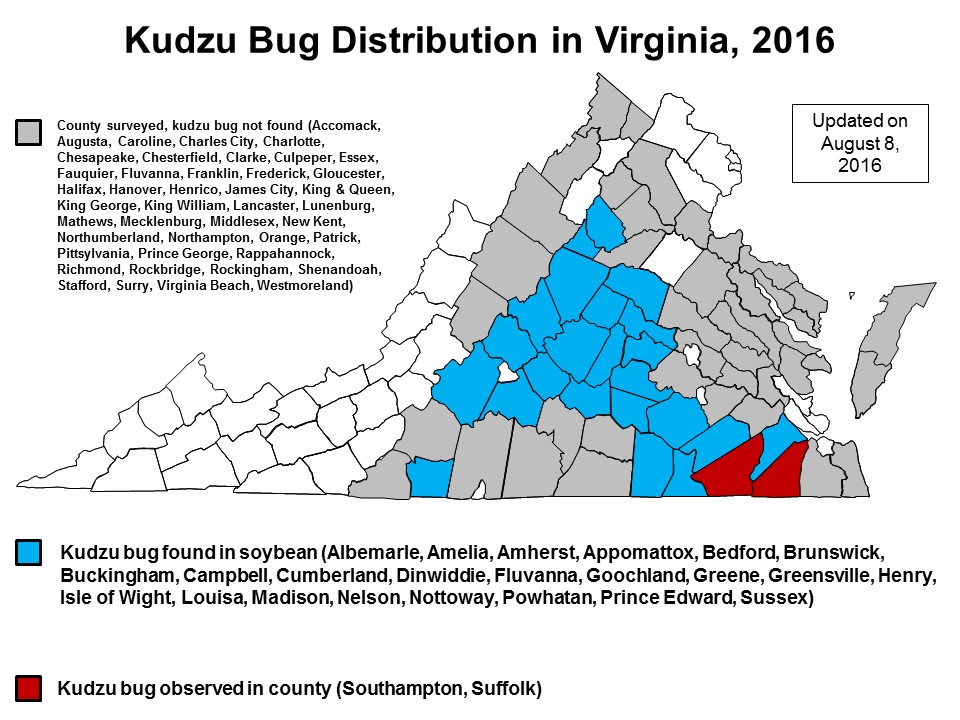 We will continue to provide updates on these insect pests of soybean throughout the season.
We will continue to provide updates on these insect pests of soybean throughout the season.
2016 Virginia Cotton Twilight Tour
The following invitation is being posted on behalf of Dr. Hunter Frame:
There will be a twilight cotton tour at the Virginia Tech Tidewater AREC Research Farm (1045 Hare Rd., Suffolk, VA) on August 31, 2016 from 4-6 pm. Supper will be provided after the tour. Please RSVP to Mrs. White by phone or email. The flyer is attached here: Tour_31_Aug_2016

